Notice: Function Elementor\Controls_Manager::add_control_to_stack was called incorrectly. Cannot redeclare control with same name "eael_image_masking_upload_pro_message". Please see Debugging in WordPress for more information. (This message was added in version 1.0.0.) in /home/amawjvtk/public_html/wp-includes/functions.php on line 6121
Notice: Function Elementor\Controls_Manager::add_control_to_stack was called incorrectly. Cannot redeclare control with same name "eael_image_masking_upload_pro_message". Please see Debugging in WordPress for more information. (This message was added in version 1.0.0.) in /home/amawjvtk/public_html/wp-includes/functions.php on line 6121
Experience the Depth of Dried Bell Pepper Flavor
What are the health Benefits of Dried Bell Pepper?

Bell Pepper is a nutrient-dense food, meaning they are high in vitamin C, A, K1, B6, E, potassium, fibre and minerals, contain no unhealthy fat and low in calories.
Dried bell peppers offer a concentrated burst of flavor and versatility that enhances culinary creations with ease. Retaining the essence of their fresh counterparts, dried bell peppers provide convenience without compromising on taste, making them a valuable ingredient in various dishes from soups and stews to salads and sauces. Their robust flavor profile and extended shelf life make them a pantry staple for adding depth and complexity to recipes year-round. Whether rehydrated for a burst of freshness or used directly for a rich, smoky note, dried bell peppers elevate dishes with their distinctive taste and culinary flexibility.
Health Benefits Of Dried Bell Pepper
Dried bell peppers, like their fresh counterparts, offer several health benefits despite being in a dehydrated form. They are rich in essential vitamins, particularly vitamin C, which supports immune function, promotes skin health, and acts as a powerful antioxidant that protects cells from damage caused by free radicals. Additionally, dried bell peppers contain vitamin A, which is crucial for vision, immune function, and skin health.
These dried peppers also provide dietary fiber, which supports digestive health by promoting regular bowel movements and aiding in the prevention of constipation. Fiber also helps regulate blood sugar levels and may contribute to a lower risk of heart disease by lowering cholesterol levels.
Furthermore, dried bell peppers are a good source of minerals such as potassium, which helps regulate blood pressure and supports proper muscle and nerve function. They also contain small amounts of iron, which is essential for oxygen transport throughout the body and plays a role in energy production.
The drying process concentrates the nutrients found in fresh bell peppers, making dried bell peppers a convenient way to incorporate vitamins, minerals, and antioxidants into your diet. However, it’s important to note that dried bell peppers may be higher in sodium compared to fresh ones, depending on the preservation method used. Therefore, it’s advisable to consume them in moderation as part of a balanced diet to reap their health benefits effectively.
It is Known to Improve eye and skin health, provide Immune system support, Prevent anaemia, Reduce inflammation condition and arthritis, possess good antioxidant properties, Protect against cardiovascular disease, and Prevents cancer
Brief History Of Dried Bell Pepper
Peppers are native to Mexico, Central America, the Caribbean and northern South America. Pepper seeds were imported to Spain in 1493 and then spread through Europe and Asia. The mild bell pepper cultivar was developed in the 1920s, in Szeged, Hungary. Preferred growing conditions for bell peppers include warm, moist soil in a temperature range of 21 to 29 °C (70 to 84 °F).
The name pepper was given by Europeans when Christopher Columbus brought the plant back to Europe. At that time, black pepper (peppercorns), from the unrelated plant Piper nigrum originating from India, was a highly prized condiment. The name pepper was applied in Europe to all known spices with a hot and pungent taste and was therefore extended to genus Capsicum when it was introduced from the Americas. The most commonly used name of the plant family chile is of Mexican origin, from the Nahuatl word chilli.
The terms bell pepper (US, Canada, Philippines), pepper or sweet pepper (UK, Ireland, Canada, South Africa, Zimbabwe), and capsicum (Australia, Bangladesh, India, Malaysia, New Zealand, Pakistan and Sri Lanka) are often used for any of the large bell-shaped peppers, regardless of their color. The fruit is simply referred to as a “pepper”, or additionally by color (“green pepper” or red, yellow, orange, purple, brown, black). In the Midland region of the U.S., bell peppers, either fresh or when stuffed and pickled, are sometimes called mangoes.
In some languages, the term paprika, which has its roots in the word for pepper, is used for both the spice and the fruit – sometimes referred to by their color (for example groene paprika, gele paprika, in Dutch, which are green and yellow, respectively). The bell pepper is called “パプリカ” (papurika) or “ピーマン” (pīman, from French piment pronounced with a silent ‘t’) in Japan.In Switzerland, the fruit is mostly called peperone, which is the Italian name of the fruit. In France, it is called poivron, with the same root as poivre (meaning “pepper”) or piment. In Spain it is called pimiento morrón, the masculine form of the traditional spice, pimienta and “morrón” (snouted) referring to its general shape. In South Korea, the word “피망” (pimang from the French piment) refers to green bell peppers, whereas “파프리카” (papeurika, from paprika) refers to bell peppers of other colors. In Sri Lanka, both the bell pepper and the banana pepper are referred to as a “capsicum” since the bell pepper has no Sinhalese translation. In Argentina and Chile, it is called “morrón”.
REFERENCES